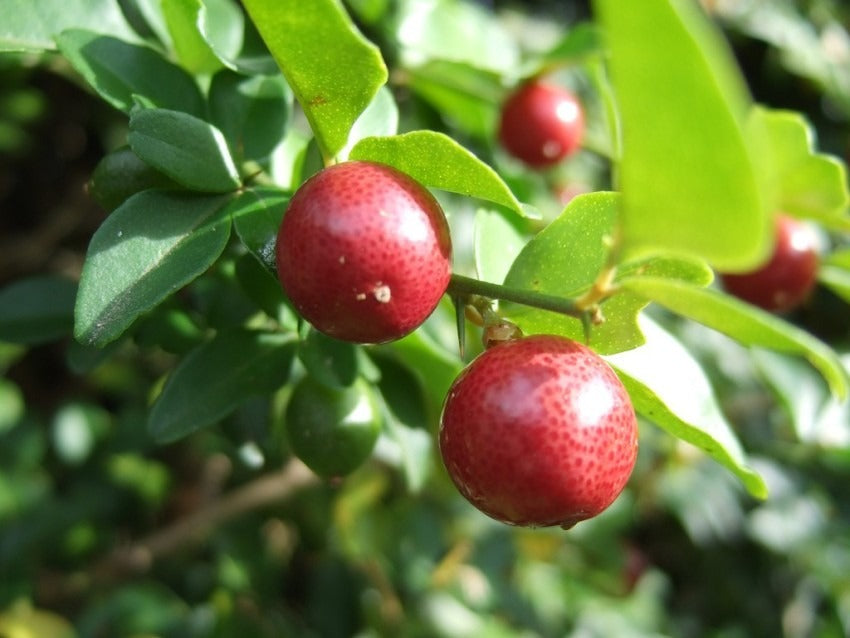Plantparadise
Red Pati Lemon Plant
Red Pati Lemon Plant
Regular price
Rs. 789.00
Regular price
Rs. 2,019.00
Sale price
Rs. 789.00
Unit price
per
Couldn't load pickup availability
Red lemons, botanically classified as Citrus limonimedica ‘Pigmentata,’ are a rare variety belonging to the Rutaceae or citrus family. The pigmented lemons are not true lemons, but a hybrid of a lemon and a citron believed to be native to the Mediterranean. Red lemons are not commercially produced as their shelf life is very short, sometimes only lasting for 2 to 3 days. The unusual variety is cultivated on a small scale through specialty growers as a boutique citrus and is offered as a seasonal delicacy during the winter season. Red lemons are known by several names throughout Europe, including Rosso Lemons, Limone Rosso, Mulled Wine Lemon, Red Citron, Blushing Lemons, and Red Pigmented Lemons. The colorful citrus is also grown as a novel fruit tree in home gardens and is favored for its fast-growing nature and ornamental appearance, providing fragrant white blossoms in the spring and summer, lush dark green leaves almost year-round, and colorful red-orange fruits in the late fall through winter. Red lemons are used similarly to common yellow lemons, zested and juiced for their bright flavoring and incorporated into an array of culinary preparations and beverages.
Red lemons are an excellent source of vitamin C to strengthen the immune system, fiber to stimulate the digestive tract, and phosphorus and calcium to build strong bones and teeth. The fruits are also a good source of potassium to balance fluid levels within the body, magnesium to support optimal nerve functioning, and contain other nutrients, including copper, vitamin B6, and iron. The pigmentation found within the rind and flesh is due to the presence of lycopene and other antioxidants that help to protect the cells against the oxidative stress caused by external environmental aggressors.
Red lemons have a tart, sour, and faintly sweet flavor well suited as a flavor enhancer in fresh and cooked preparations. The juice and zest are the primary elements used, and both are traditionally mixed to add a bright element to salad dressings, sauces, syrups, oils, and jams. Red lemon juice can also be squeezed over grain bowls, salads, and seafood dishes, or it can be sprinkled over tacos, pasta, soups, and roasted vegetables to add a touch of acidity. In addition to the juice, Red lemon zest can be incorporated into cakes, muffins, cookies, and other baked goods or folded into icings, glazes, and fillings. Beyond culinary dishes, the zest and juice are customarily blended into carbonated beverages, cocktails, and other drinks. The rind can also be dried and steeped into tea or candied as a sweet treat. Red lemons pair well with other fruits such as berries, apricots, cherries, peaches, and plums and herbs, including mint, basil, thyme, and rosemary. Whole, unwashed Red lemons have a short shelf life and will only keep 2 to 3 days when stored in the refrigerator’s crisper drawer.
Red lemons are marketed as an ornamental holiday cultivar in Italy. The red-blushed lemons come into season during the winter and are sold as a premium citrus over Christmas and New Year’s, advertised as a festive addition to holiday dinner tables. The color red has historically represented wealth, good luck, and fertility in Italy and can be traced back to Roman times when both women and men would wear red clothing as a symbol of wealth and power. Mosaics in Pompeii depict the popularity of red clothing, so much so that Pantone named a shade of red after the clothing, known as “Pompeian Red.” In the modern-day, red is still worn during the holiday season to symbolize good luck and prosperity. Red lemons are marketed as a complementary festive decoration dawning the prosperous coloring. The variegated citrus can be placed in bowls as decoration, or they can be sliced and dropped into drinks, showcasing a piece of their colorful rind. The lemons can also be saved for New Year’s festivities, as their coloring will match the shade of the customary underwear worn. Department stores and shops throughout Italy sell red underwear between Christmas and New Year’s, and red underwear is an ancient Italian superstition thought to bring good luck, fertility, and wealth in the year to come if worn during the nighttime celebrations.
Nutritional Value
Red lemons are an excellent source of vitamin C to strengthen the immune system, fiber to stimulate the digestive tract, and phosphorus and calcium to build strong bones and teeth. The fruits are also a good source of potassium to balance fluid levels within the body, magnesium to support optimal nerve functioning, and contain other nutrients, including copper, vitamin B6, and iron. The pigmentation found within the rind and flesh is due to the presence of lycopene and other antioxidants that help to protect the cells against the oxidative stress caused by external environmental aggressors.
Applications
Red lemons have a tart, sour, and faintly sweet flavor well suited as a flavor enhancer in fresh and cooked preparations. The juice and zest are the primary elements used, and both are traditionally mixed to add a bright element to salad dressings, sauces, syrups, oils, and jams. Red lemon juice can also be squeezed over grain bowls, salads, and seafood dishes, or it can be sprinkled over tacos, pasta, soups, and roasted vegetables to add a touch of acidity. In addition to the juice, Red lemon zest can be incorporated into cakes, muffins, cookies, and other baked goods or folded into icings, glazes, and fillings. Beyond culinary dishes, the zest and juice are customarily blended into carbonated beverages, cocktails, and other drinks. The rind can also be dried and steeped into tea or candied as a sweet treat. Red lemons pair well with other fruits such as berries, apricots, cherries, peaches, and plums and herbs, including mint, basil, thyme, and rosemary. Whole, unwashed Red lemons have a short shelf life and will only keep 2 to 3 days when stored in the refrigerator’s crisper drawer.
Ethnic/Cultural Info
Red lemons are marketed as an ornamental holiday cultivar in Italy. The red-blushed lemons come into season during the winter and are sold as a premium citrus over Christmas and New Year’s, advertised as a festive addition to holiday dinner tables. The color red has historically represented wealth, good luck, and fertility in Italy and can be traced back to Roman times when both women and men would wear red clothing as a symbol of wealth and power. Mosaics in Pompeii depict the popularity of red clothing, so much so that Pantone named a shade of red after the clothing, known as “Pompeian Red.” In the modern-day, red is still worn during the holiday season to symbolize good luck and prosperity. Red lemons are marketed as a complementary festive decoration dawning the prosperous coloring. The variegated citrus can be placed in bowls as decoration, or they can be sliced and dropped into drinks, showcasing a piece of their colorful rind. The lemons can also be saved for New Year’s festivities, as their coloring will match the shade of the customary underwear worn. Department stores and shops throughout Italy sell red underwear between Christmas and New Year’s, and red underwear is an ancient Italian superstition thought to bring good luck, fertility, and wealth in the year to come if worn during the nighttime celebrations.
Materials
Materials
Shipping & Returns
Shipping & Returns
Dimensions
Dimensions
Care Instructions
Care Instructions






